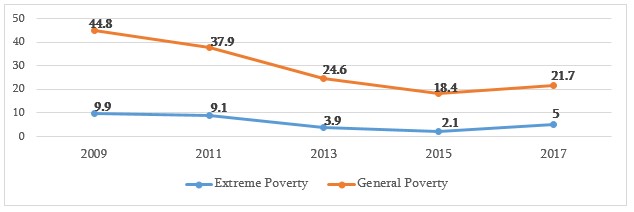Dimitri Khundadze: “In the last ten years, there has been a trend of declining poverty.”
Verdict: FactCheck concludes that Dimitri Khundadze’s statement is HALF TRUE.
Resume: Prior to the outbreak of the pandemic, almost a fifth (19.5%) of the Georgian population lived in poverty whilst the poverty rate reached 21.3% in 2020. In accordance with the National Statistics Office of Georgia (as well as the World Bank, the poverty level dropped from 37.3% to 21.3% in 2011-2015. In 2016, the share of people living under the poverty line increased slightly whilst poverty levels remained nearly unchanged in 2017. In 2018-2019, the absolute poverty decreased from 21.9% to 19.5%.
According to UNICEF’s latest figures (as referred to by Dimitri Khundadze), the general poverty rate increased from 18.4% to 21.7% in 2017 as compared to 2015 whilst the portion of people living in extreme poverty increased from 2.1% to 5%. In 2017, extreme child poverty increased most sharply from 2.5% to 6.8%. In 2011-2015, both the extreme and the general poverty rates have been declining in Georgia. According to the UN’s Food and Agriculture Organisation’s (FAO) 2020 report, 8.2% of the Georgian population (over 300,000 people) is malnourished according to 2019’s data. According to Global Hunger Index 2019 report, Georgia is ranked 39th among 117 world countries. Georgia’s position in the Global Hunger Index has worsened as compared to the latest 2010 figures.
The poverty level in Georgia has decreased over the last ten years. However, the trend of declining poverty was seen from 2011 to 2016 and the poverty rate increased in the country thereafter. In 2018-2019, the poverty rate continued to decline at a comparably slower pace. At the same time, hunger (malnourishment) remains Georgia’s most acute challenge and the situation in this regard has not improved.
Analysis
On 11 June 2021, at the plenary session of the Parliament of Georgia, Parliamentary Majority MP, Dimitri Khundadze, stated: “Indeed, poverty is a problem; particularly, child poverty. However, saying that children die from hunger in the country is a grave allegation against one’s own country. Read the World Bank and UNICEF data. In the last ten years, there has been a trend of declining poverty.” FactCheck verified the acuteness of extreme poverty and the problem of starvation in the country and took a look at the trend over the last years.
Georgia’s national poverty line as published by the World Bank reflects the data of the National Statistics Office of Georgia. The absolute poverty calculation methodology is based on World Bank’s Basic Needs Approach and the subsistence minimum is used as the poverty line. Job and income loss amid the pandemic was a particularly devastating problem which caused impoverishment. According to the National Statistics Office of Georgia, the share of people living under the absolute poverty line increased by 1.8 percentage points in 2020 and reached 21.3%.
Poverty was Georgia’s biggest challenge prior to the outbreak of the pandemic as nearly a fifth (19.5%) of the population lived in absolute poverty. In accordance with the National Statistics Office of Georgia (as well as the World Bank), there was a poverty decline trend in 2011-2015 and it decreased from 37.3% to 21.3%. In 2016, the share of people living under the poverty line increased slightly whilst poverty levels remained nearly unchanged in 2017. In 2018-2019, absolute poverty decreased from 21.9% to 19.5% (see Graph 1).
Graph 1: Share of Population Under the Absolute Poverty Line

Source: National Statistics Office of Georgia
In regard to UNICEF’s data, the Well-being of Children and Their Families in Georgia research is conducted in every two years. These reports reflect the figures for 2009-2017. The poverty and welfare of the population is assessed on the basis of a consumer expenses analysis. When a person spends less than USD 1.25 a day, which corresponds to GEL 82.8 per month for an adult, he is considered as living in extreme poverty. UNICEF’s latest report from 2017 indicates that poverty figures have increased in Georgia. The poverty rate increased in every group of the population, although child poverty figures have increased the most.
According to UNICEF, both the general and the extreme poverty figures were declining in Georgia in 2011-2015. In 2017, the general poverty rate increased from 18.4% to 21.7% as compared to 2015 whilst the portion of people living in extreme poverty increased from 2.1% to 5% (see Graph 2). In 2017, the extreme child poverty rate increased most sharply from 2.5% to 6.8%. Of note is that extreme child poverty decreased from 11.5% to 2.5% in 2009-2015.
Graph 2: Extreme and General Poverty Figures in 2009-2017

Source: UNICEF’s Welfare of the Population Reports
Dimitri Khundadze denies that children die of hunger in the country and says it is a grave allegation. However, for Georgia, as well as globally, hunger is one of the biggest challenges and is largely caused by extreme poverty and the lack of material access to food. FactCheck would like to clarify that hunger implies malnourishment (the portion of food which has insufficient energy value for an active and healthy life). Malnourishment damages health and causes different non-contagious diseases which may lead to death. As clarified by UNICEF, malnourishment is stipulated by poverty, urbanisation, climate change and a scarcity of food.
One of the UN’s sustainable development goals is the eradication of poverty. In September 2020, the UN’s Food and Agriculture Organisation (FAO) published the State of Food Security and Nutrition in the World report which assesses the global situation in regard to hunger. According to the report, 8.2% of the Georgian population (over 300,000 people) is malnourished as of 2019. Of note is that Georgia’s figure is three times higher as compared to the same figures for other Caucasus region countries. The report says that 8.9% (nearly 690 million people) is malnourished.
According to Global Hunger Index 2019, Georgia is ranked 39th among 117 world countries. Georgia’s position in the Global Hunger Index has worsened as compared to the latest 2010 figures and the county lags behind its neighbours. In the Eastern Europe region, Georgia only outperforms Turkmenistan and Uzbekistan. The Global Hunger Index is based on the following indicators: population undernourishment, the share of children under the age of five who are suffering from child wasting, the share of children under the age of five who are suffering from child stunting and the mortality rate of children under the age of five.
It is a fact that hunger and extreme poverty remain as one of Georgia’s biggest challenges and various data illustrate that the situation has worsened in some respects in the last years let alone being improved.








